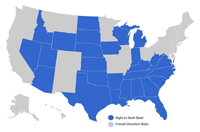| |
|
| |
|
 |
Supply
Chain by the Numbers |
| |
|
| |
- March 16, 2017 -
|
| |
|
| |
|
| |
|
| |
US Infratructure Gets Rotten Grade Once Again from ASCE; UPS Keeps Adding to its Nat Gas Fleet and Network; Right to Work States Adding All the Manufacturing Jobs; It's Easy to Understand Why We have a Driver Shortage |
| |
|
| |
| |
| |
|
|
 |
That is by how much manufacturing employment grew between 2011 and 2016 in the 22 states that had Right to Work laws as of 2011, according to data released by the Labor Department on March 13. That's roughly double the percentage increase for the 24 states where compulsory union dues were still permitted in 2016. Perhaps surprisingly, 2015 average annual compensation per Right to Work state manufacturing employee was $76,454, roughly $3,800 higher than the average for states that still lacked Right to Work protections in 2015. Early this year, Kentucky and Missouri became the 27th and 28th Right to Work states. There are active efforts in both New Hampshire and Ohio to change to Right to Work status as well. Employment in Right to Work states exceeded that of non-Right to Work states by 200,000 inn 2016, and that was before the changes in Kentucky and Missouri earlier this year.
|
| |
| |
|
| |
| |
$25-30,000 |
|
That is all the pay that drivers for truckload carrier Celadon make in their first year on the job, according to a recent article in The Atlantic magazine. After the first year, drivers can make over $50,000 annually - still not much for a pretty grueling job that involved many nights away from home. Other carriers are roughly in the same pay range, though some have increased pay in the last two years to address the driver shortage. But in the end, "The job is terrible, and the companies know it," says Steve Viscelli, a University of Pennsylvania sociologist and the author of The Big Rig: Trucking and the Decline of the American Dream, a book for which he spent several months as a driver as part of his research. Carriers sell the idea of being a contractor to drivers with the vision of being their own bosses, but the arrangement often saddles them with unsustainable debt and high expenses, Viscelli notes. Those drivers starting as independent contractors sign lease-to-own deals to purchase their vehicles, often with the carrier. But the contract terms are onerous, Viscelli says, and drivers owe so much that they may end up working 70 or 80 hours a week just to pay back what they owe and cover expenses such as fuel and insurance. It should be no surprise there is a driver shortage, Viscelli says. |
| |
| |
|
|
|
| |
 |
 |
| |
|
|
| |